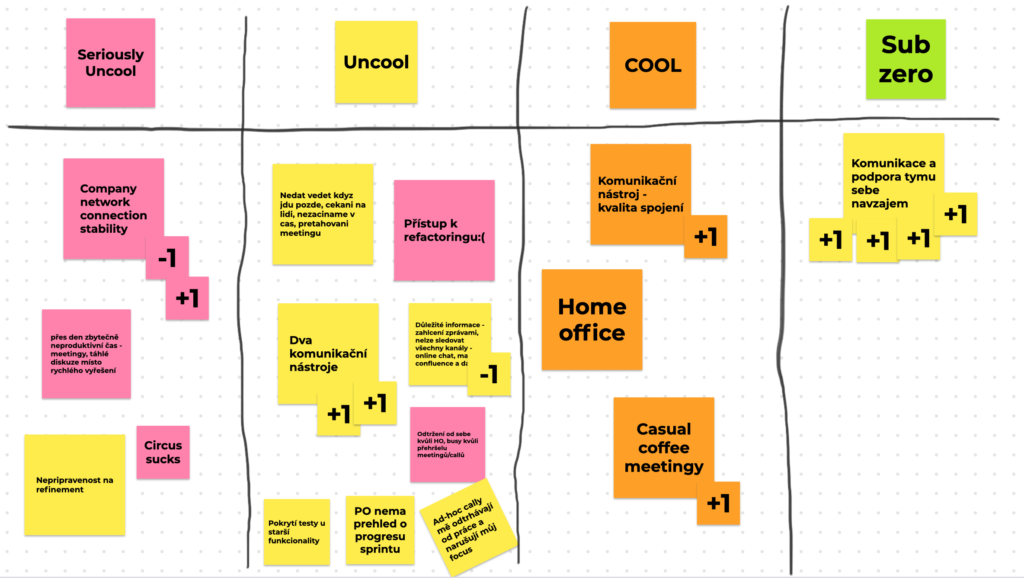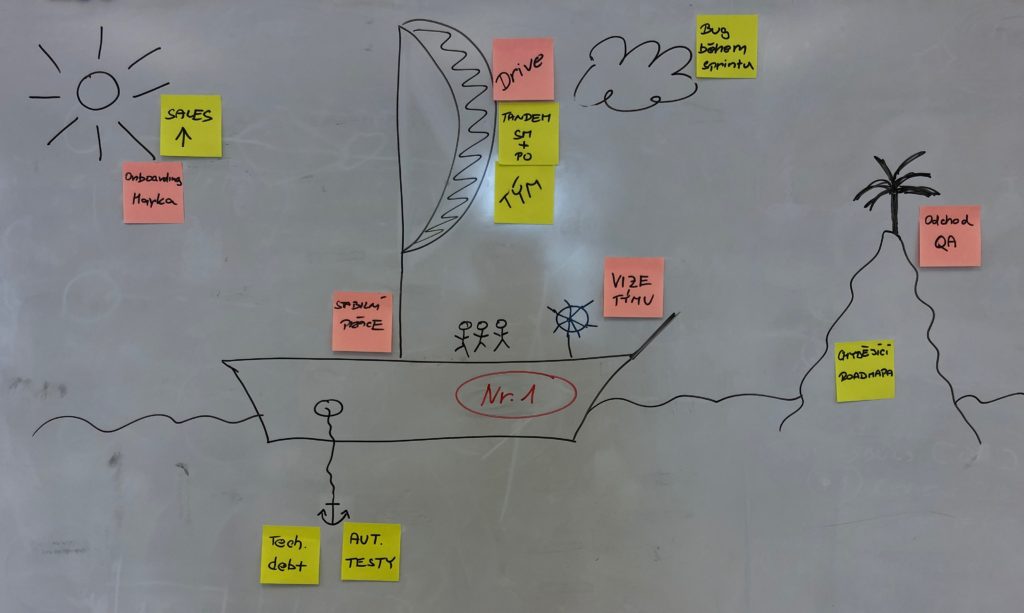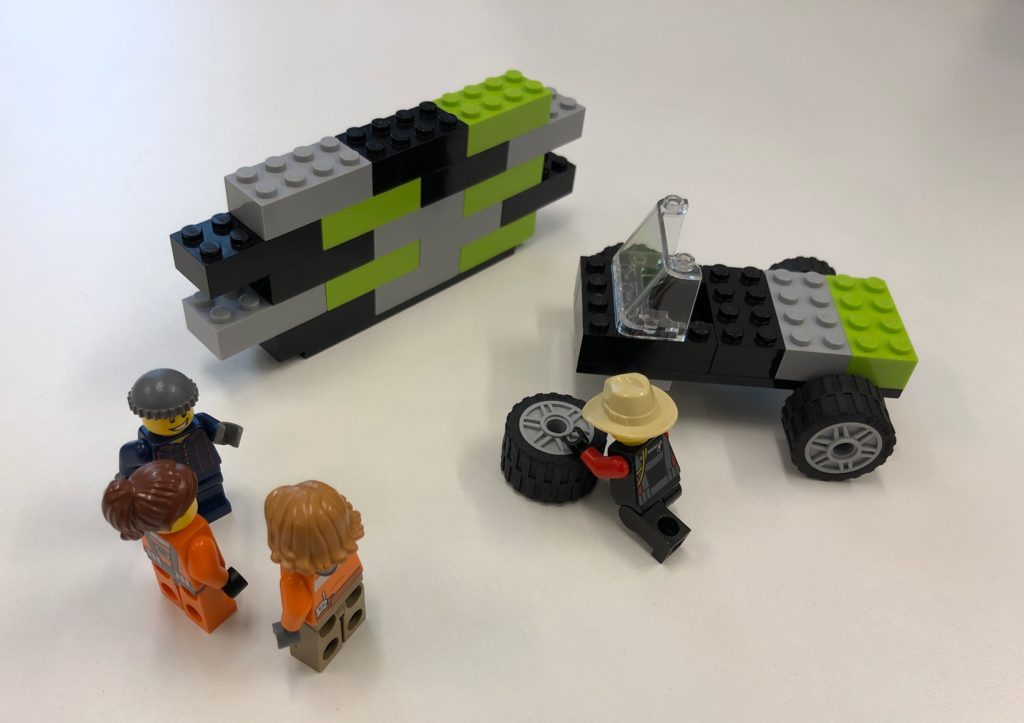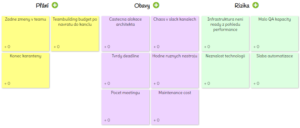Have you reached a state where your retrospectives are like a copycat? Are you wondering how to revitalize them and give your team a new impetus? If you haven’t already read our article Mastery in retrospectives (in Czech language only), be sure to check it out, you’ll find plenty of valuable tips. In addition to tips on how to achieve an imaginary agile paradise in retrospectives, we’ve compiled a few other tips that can help break your team out of the rut and bring back the forgotten lustre of retrospectives. Try unconventional formats, interesting online tools, or just add a new element to your retrospectives.
Non-traditional formats of retrospectives
Many teams settle for the classic “+/-” retrospective format. A different format won’t automatically guarantee success, but it will help people see things from a different perspective. All of these formats can be practised not only with your team in the office but also online.
Top Gear
Do you know the Cool Wall from Top Gear where they rate cars? Have you ever thought of doing a retrospective in that vein? Create a wall just like the one in the video and ask your team to fill it with whatever they think is important (company, product, people, team, processes, …). Then discuss together which things you would like to move more to the right. The “Subzero” column is an imaginary nirvana, once a card reaches this level it is so good that there is nothing more to improve on. We recommend doing the retrospective again in maybe a quarter of a year and seeing what has changed.

Boat
Imagine that as a team you have the task of drawing a ship. The facilitator asks you to draw large sails, a rudder, an anchor and last but not least a reef in front of the boat. You will then be asked to write on sticky notes everything that was important to you over the past sprint, either positive or negative. Once you have written, you take the sticky notes and stick them on the parts of the boat that best capture the essence of the note. For example, “sails propel us forward, which is why I’m putting automated tests here because they help us greatly and speed things up” or “a lot of red tape is dragging us down”, which is why I’m putting them at anchor.

LEGO
If you’re interested in how your team members view the just-ended Sprint, want to encourage creativity and do some team building, choose the Lego retrospective. Put a bunch of different Lego bricks in front of the team and have everyone build whatever they think represents the last Sprint. Someone will build, for example, characters talking to each other, someone will build a broken down car pointing out problems in the team, and creative individuals can use the bricks to visualize the mess in the backlog, for example. This format will help you understand how individual team members perceive teamwork.

Futurospective
Do you have a challenging project or initiative coming up? Try taking a retrospective from the other side and looking to the future. Questions to ask in this special retrospective include:
Wishes – What do we wish would come true in the future?
Concerns – What are our concerns as a team?
Risks – What do we see as the risks and how can we minimize them?
This activity will then make the whole team better prepared for almost anything that comes up during the project.
Online tools
If you have part of your team in a home office, you can take advantage of great online tools. Here are a few that we love to use and can highly recommend.
Jamboard
A simple free tool from Google that works like a virtual whiteboard. You can draw on it, add sticky notes, erase, etc. – there are no limits to your imagination. The only advantage and disadvantage is its simplicity.
Miro
Probably the most comprehensive remote collaboration tool at the moment – it supports everything from Story mapping meeting design to Kanban boards, roadmaps, mindmaps and scaling agile development.
Ideaboardz
A simple and free version of the retrospective board that includes predefined templates for some formats, or you can create your own. The tool supports simple voting, which you will appreciate when choosing a topic to discuss.
Funretro
A more advanced paid alternative to Ideaboardz that offers multiple predefined formats, comments on individual notes, limiting the number of votes, hiding results during voting for a more objective outcome, simple export and many other convenient options to make retrospective facilitation as easy as possible.
New element
They say that even the little things matter. If you and your team aren’t in the mood for a big change, here are a few tips that don’t cost much but can help a lot.
Sprint timeline – create a timeline for the office where everyone can mark the key Sprint moment along with positive or negative emotions. This way, the topic won’t be forgotten in the retrospective.
Ad-hoc retrospectives – don’t wait for the big retrospective after 14 days, but instead give people on the team the opportunity to convene an ad-hoc retrospective and address the topic immediately at any time during the day. You will benefit from the outcome immediately.
Mood cards – use them as an ice-breaker at the beginning of the retrospective. The goal is to find out how someone on the team is feeling right now. You can buy whale cards with different grimaces on them, which you toss on the floor and everyone picks one and describes why they picked it and how they feel.
Statistics window – show the team interesting statistics at the beginning. You can show the trend of the number of bugs, technical debt, a success rate of planning or maybe customer satisfaction with your product.
Positive retrospective – nothing negative can be said at today’s meeting, we just praise each other and look at what we are doing well either as individuals or as a team.
Retrospective of a retrospective – set aside the last 10 minutes to do a retrospective of the retrospective you just finished. Clarify as a team where the retrospectives are working and where there is room for improvement.
Finally, we would like to encourage you to experiment with retrospectives. There’s nothing worse than a team that’s been going the same way for six months, repeating the same format over and over again, and a meeting that has long since left life. Try something new, whether it’s a small thing or a big thing – the worst thing that can happen is that it goes wrong. At least you’ll know which way is wrong…


